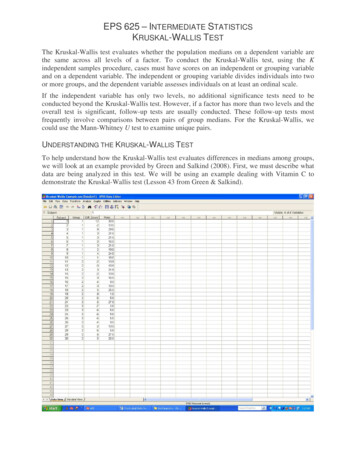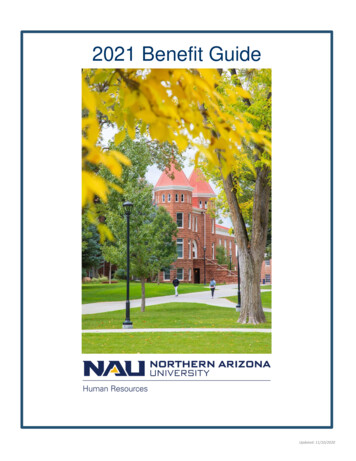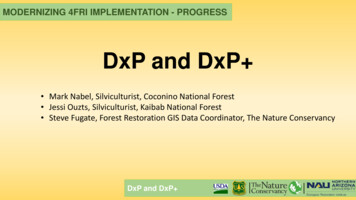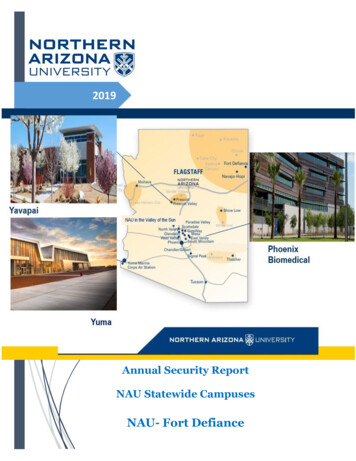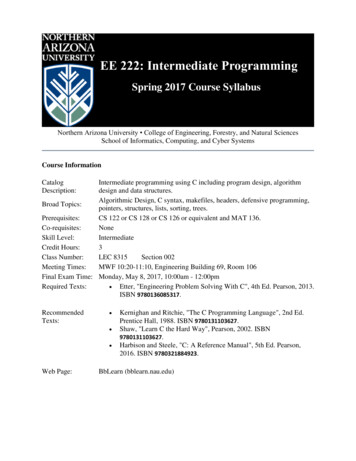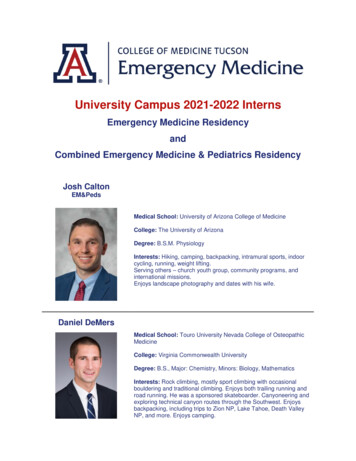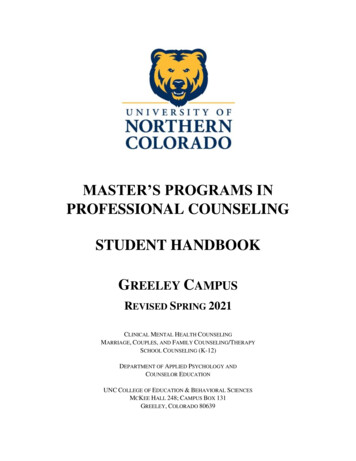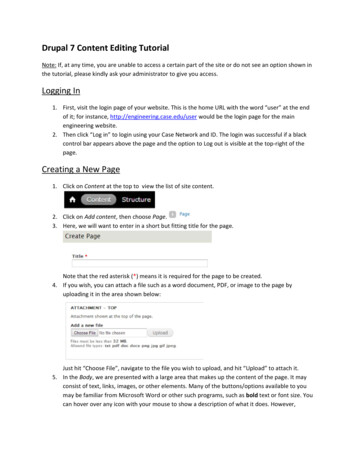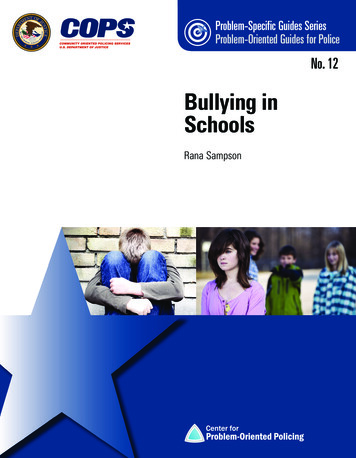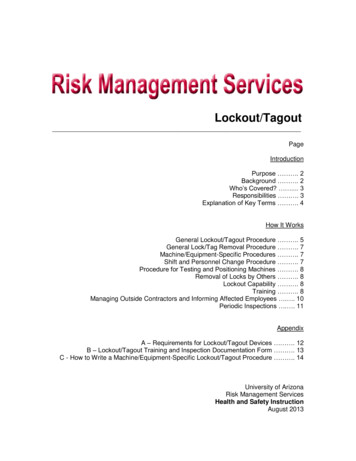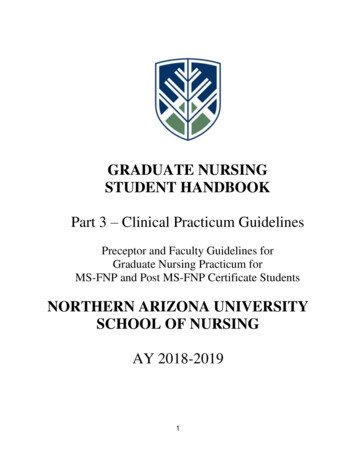
Transcription
GRADUATE NURSINGSTUDENT HANDBOOKPart 3 – Clinical Practicum GuidelinesPreceptor and Faculty Guidelines forGraduate Nursing Practicum forMS-FNP and Post MS-FNP Certificate StudentsNORTHERN ARIZONA UNIVERSITYSCHOOL OF NURSINGAY 2018-20191
Thank-you from the Northern Arizona University School of NursingThank you for agreeing to be a preceptor! In serving as a preceptor to a family nurse practitionerstudent from the Northern Arizona School of Nursing Graduate Program you have a unique opportunityto make a profound professional impact. Your advanced knowledge and skills provide a vital componentto the development of competency in the professional nurse under your guidance.As a preceptor, you will mentor a student as he/she transitions into the role of an advancedpractice nurse. An important responsibility of a preceptor is to facilitate application of the knowledgestudents learn in their course work with actual clinical experiences. In the clinical setting the student willwork directly with you, and under your supervision, to plan, provide, and evaluate patient care. Alongwith the student you will decide what learning experiences are needed to meet the student’s goals and theoutcomes of the course. While NAU nursing faculty is not present on-site, scheduled visits will be madewith you and the student and you may call upon a nursing faculty member at any time with questions orconcerns.As you read through these documents, please do not hesitate to call the School of Nursing duringregular business hours with any questions. In addition, clinical site preceptors and students will beprovided with contact information for the NAU supervising clinical faculty prior to the student’splacement at the clinical site. This faculty member will be available to you at any time.Although NAU provides no financial compensation for your service, the Universityacknowledges your participation in this program and graciously appreciates your endeavors in furtheringthe development of advanced practice nursing. If you are interested in pursuing adjunct faculty status atNAU we would be happy to discuss this with you. Again, we appreciate your willingness to promote theeducation of future family nurse practitioners. It is a valuable contribution that we hope will also bepersonally and professionally satisfying for you.Thank you!Pamela Stetina, RN, PhDDirector & Clinical ProfessorSchool of NursingPamela.Stetina@nau.eduChristina Mooroian-Pennington, DNP, RN, FNP-CAssistant Clinical ProfessorCoordinator, Family Nurse Practitioner ProgramsSchool of NursingChristina.Mooroian-Pennington@nau.edu2
Table of ContentsIntroduction . 4Mission, Organizing Framework, and Curricular Model .5Authority and Accreditation . 7NAU Masters of Nursing Program Outcomes . 8Definitions .9FNP Clinical Practicum Policies and Procedures .10Student Health Requirements for Clinical Practicum .12ResponsibilitiesProgram Coordinator . 15Supervising Course Faculty . 16Preceptor . 18Student . 22References . 24AppendicesAppendix A:TYPHON Reference Information .25Appendix B:FNP Student Evaluation of Preceptor and Clinical Site .26Appendix C:Student Injury/Incident Report . 28Appendix D:Student Responsibility Statement . 29Appendix E:FNP Preceptor Evaluation of Student . 30Appendix F:FNP Course Descriptions and Outcomes .32Appendix G:FNP Course Progression AlgorithmAppendix H:FNP Minimum Clinical Requirements .39Appendix I:Preceptor Acknowledgement Receipt .403.36
IntroductionThis document has been prepared as a resource for clinical site preceptors and Northern ArizonaUniversity (NAU) School of Nursing (SON) family nurse practitioner (FNP) students and faculty. Theinformation contained herein describes the roles and responsibilities of preceptors, faculty, and students,as well as guidelines, policies, and procedures pertaining to the clinical practicum for FNP students. Thepolicy elements of this document are adapted from recommendations established by the NationalOrganization of Nurse Practitioner Faculties (NONPF) and published in Partners in NP Education: APreceptor Manual for NP Programs, Faculty, Preceptors, & Students (2000)1. Preceptors, students, andfaculty are encouraged to review these documents thoroughly, as it is important to be familiar with thecontents.The NAU SON operates under the legal authority of the Arizona State Board of Nursing (AZBON) and isfully accredited by the Commission on Collegiate Nursing Education (CCNE). The SON is an academicunit in the College of Health and Human Services (CHHS) at NAU.In addition to the information provided in this document, NAU and SON policies regarding specificclinical issues can be found in the Graduate Student S/Nursing/Graduate Handbook.pdfThe School of Nursing adheres to all University mandates and guidelines developed to provide a safe andprogressive learning environment. Detailed information is provided on the NAU website:http://home.nau.edu/4
OverviewDescriptionNorthern Arizona University is a doctoral-research intensive university with its main campus in Flagstaff.NAU-Yuma shares a campus with Arizona Western College in Yuma, Arizona, and NAU DistanceLearning serves more than 6,000 students at 30 other sites throughout Arizona.Mission of Northern Arizona UniversityProvide an outstanding undergraduate residential education strengthened by important research, graduate,and professional programs and a responsive distance learning network delivering programs throughoutArizona.Mission of School of NursingThe mission of Northern Arizona University’s School of Nursing is to provide outstanding education tostudents at the undergraduate, master’s and doctoral level who can provide high quality health careservices to individuals and diverse communities in an environment of constant change and emerginghealth care trends.PhilosophyThe philosophy of the SON at NAU is based on an ethic of caring that embraces students, faculty, staff,and the university and global communities where we live and work. We also believe that caring is aconscious intentional discipline that is part of nursing’s unique body of knowledge and is practiced ininterdisciplinary contexts. Caring includes the creation and nurturing of an environment that recognizesthat students, staff, and faculty have unique ways of viewing the world. This philosophy promotesexcellence for nursing education and practice in an environment of constant change and emerginghealthcare trends.The faculty believes the transition to the role of competent professional nurse is a major developmentalachievement. We believe that nursing is an art and science that is an integral component of healthcare.Applying the discipline of nursing to practice depends on a foundation of natural and human sciences,humanities and arts, application of research, and the diverse backgrounds of learners. Societal influencesin the evolving healthcare system challenge all involved in nursing education.Education is a dynamic, life-long collaborative process by which an individual pursues life goals,broadens human potential, develops thinking, and clarifies values. The faculty believes that learning is theintentional acquisition, application, and integration of knowledge, skills, and attitudes. Learning is shapedby the environment and developmental level of the learner, and is ultimately the responsibility of thelearner. Faculty plan, guide, and facilitate learning while supporting the learning needs of a diversecommunity of students. We believe that learning-centered experiences with rigorous expectations andactively engaged students result in higher-level thinkers and graduates prepared for real world practice.We value incorporating rural and global healthcare into a variety of educational experiences. Thus,education not only expands the thinking of the learner, but also increases opportunities for application.Graduate EducationThe faculty believes that education is a life-long active process. Education provides a mechanism bywhich an individual pursues life goals, broadens human potentials and opportunities, develops creativethinking, and clarifies values.Learning and teaching is a collaborative process between faculty and students. The process involvesdeveloping and achieving the behavioral changes that are specified in the program and course outcomes.Nursing at the graduate level at NAU is based on undergraduate preparation as a generalist. Master’s level5
nursing involves analysis, synthesis, evaluation, and application of knowledge and skills relevant to ruralhealth nursing.The dynamic interaction between the educational program and the learner facilitates progressive levels ofmaster of the nursing process. Graduate education has as its ultimate purpose the scholarly pursuit ofknowledge about people in their quest for health and recovery from illness and the consequences ofnursing care provided to them.Research is an integral part of education at the Master’s level. An attitude of scientific inquiry is fosteredas an essential component of practice. Research at this level emphasizes evidence-based practice and theutilization of research.Organizing FrameworkThe SON faculty developed an organizing framework that serves as a guide and provides direction forfaculty to organize its programs of education and to focus research, scholarship, clinical practice, andcommunity service. The aim of this framework is to prepare nursing professionals for effectiveprofessional and civic engagement. The framework represents a systematic organization of concepts thatare the essential components of baccalaureate and graduate education.Curricular ModelCurriculum includes the planned and unplanned learning that occurs in the process of advancingeducation in the discipline of nursing. Building on prior life, educational, and professional experiences,the structure of the nursing curriculum moves the learner along a continuum from novice to more expertlevels of nursing practice. Embracing the essential need for lifelong learning in the discipline, the facultydevelops curriculum to provide educational advancement from the baccalaureate through doctoral levelsof nursing practice.The graduate curriculum is based on baccalaureate achievement. The goal of this curricular approach is tointegrate and evaluate the concepts depicted in the organizing framework to promote advancedprofessional nursing. The graduate nursing curriculum integrates professional standards set forth by theNational Organization of Nurse Practitioner Faculties (NONPF), the American Association of Colleges ofNursing (AACN), and the American Nurses Association (ANA) Social Policy Statement and Code ofEthics.6
Authority and AccreditationThe NAU SON operates under the legal authority of the Arizona State Board of Nursing(AZBON) and is fully accredited by the Commission on Collegiate Nursing Education (CCNE).According to the Rules of the Arizona State Board of Nursing: R4-19-502: Requirements for AdvancedPractice Registered Nursing Program (AZBON, 2009, p. 33-58), the parent institution of an advancedpractice nursing program shall ensure that a preceptor supervising a student in clinical practice:1. Holds an unencumbered active license or multistate privilege to practice as a registered nurse orphysician in the state in which the preceptor practices or, if employed by the federal government,holds an unencumbered active RN or physician license in the United States;2. Has at least one year clinical experience as a physician or an advanced practice nurse, and3. For nurse preceptors, has at least one of the following:a. National certification in the advanced practice category in which the student is enrolled;b. Current Board certification in the advanced practice category in which the student isenrolled; orc. If an advanced practice preceptor cannot be found who meets the requirements of (3)(a)or (b), has educational and experiential qualifications that will enable the preceptor toprecept students in the program, as determined by the nursing program and verified bythe Board.In addition to the Rules of the AZBON, the NAU SON FNP plan of study conforms to the following:The Essentials of Master’s Education in NursingAmerican Association of Colleges of Nursing (2011)5.Criteria for Evaluation of Nurse Practitioner ProgramsA Report of the National Task Force on Quality Nurse Practitioner Education (2012)6.7
Northern Arizona University School of NursingMasters of Nursing Program OutcomesClinical Practice and Prevention Design patient-centered and culturally responsive strategies in the delivery of clinical prevention andhealth promotion interventions and/or services to individuals, families, communities, andaggregates/clinical populations.Communication Develop and collaborate within interprofessional teams and partnerships by using effectivecommunication strategies. Advance patient education, enhance accessibility of care, analyze practice patterns, and improvehealth care and nurse sensitive outcomes by using information and communication technologies.Critical reasoning Integrate theory, evidence, clinical judgment, research, and interprofessional perspectives usingtranslational processes to improve practice and associated health outcomes for patient aggregates.Leadership Analyze how policies influence the structure and financing of health care, practice, and healthoutcomes. Examine the effect of legal and regulatory processes on nursing practice, healthcare delivery, andoutcomes.Professionalism and Professional Values Advocate for patients, families, caregivers, communities, and members of the healthcare team. Incorporate core scientific and ethical principles in identifying potential and actual ethical issuesarising from practice, and assist patients and other healthcare providers to address such issues.Global Health and Global Engagement Transform health care systems to address health equity and social justice thus reducing healthdisparities in vulnerable populations.Diversity Education Assume leadership and/or research roles in developing, implementing, and evaluating culturallyreinforcing nursing and other health care services from local to global perspectives. Prioritize social and cultural factors that affect health in designing and delivering care across multiplecontexts.Environmental Sustainability Create partnerships that promote sustainable environmental health policies and conditions. Analyze and promotes social, political, and economic policies that influence sustainable environmentsand reduce human health exposures in a global society.8
DefinitionsProgram CoordinatorThe Program Coordinator is an NAU faculty member designated by the Director of the SON to beresponsible for the FNP programs. The Coordinator supervises didactic and clinical faculty and FNPstudents.Supervising Clinical FacultySupervising Clinical Faculty may be NAU Assistant, Associate, Professor, Clinical, or Adjunct facultywho are responsible for teaching and overseeing the clinical component(s) of the FNP courses.Clinical SiteNAU’s FNP track is a rural-focused program. Our students are prepared to provide primary health careacross the lifespan in rural and underserved communities. The clinical sites utilized for clinicalexperiences are generally rural primary care practices. Depending on student needs for clinicalexperiences, certain specialty rotations may be utilized in other types of communities.Affiliation AgreementsThe SON must have a completed Affiliation Agreement with all agencies/clinical sites in which students willbe placed for clinical experiences. This applies to all clinical experiences for any schedule during the academicyear. Students may not be permitted to begin any clinical experience with an agency/clinical site with whichthe SON does not have an Affiliation Agreement.PreceptorA preceptor is a qualified advanced practice nurse or physician who works one-on-one with an FNPstudent at a clinical site to facilitate attainment of the family primary care learning outcomes. Thepreceptor guides the student’s learning experience while acting as a clinical supervisor, role model, andmentor. The clinical practitioner-preceptor-educator promotes NP role socialization, facilitates studentautonomy and promotes self-confidence that leads to clinical competency.29
FNP Clinical Practicum Policies and ProceduresAcademic Standards and Student Evaluation CriteriaPreceptors and all clinical supervising faculty should review the course syllabus and progressionexpectations prior to contacting or meeting with the student to ensure academic and professionalstandards are understood before engaging in clinical supervision and practice. The Program Coordinatorwill provide the preceptor with evaluation criteria that describes student performance standards requiredto pass a clinical course, and those that indicate when a student is at risk for failing. Additional academicpolicies are described in the SON Graduate Student Handbook that can be found online ng/Graduate Handbook.pdfIdentifying Clinical ObjectivesThis handbook provides course and clinical practicum objectives, which are located in the appendices.Interview with the PreceptorWhen/if a student identifies a potential clinical site or preceptor, the Program Clinical Coordinator willcontact the clinician and clinical site and initiate the process for a clinical site agreement. Studentpreceptor interviews are not required for clinical placement, but in some instances may be arranged.Scheduling Clinical HoursThe student should schedule clinical practicum hours that are in keeping with the preceptor’s scheduleand availability - not the student's schedule or convenience. Prior to beginning the clinical practicumstudents and preceptors need to agree on the days and times that the student will be in the clinical agency.The student's personal and work schedules are expected to accommodate participation in the requirednumber of clinical hours specified by the clinical course. Students may not begin clinical practicum hoursbefore the first official day of the semester that the course begins. All required supervised practice hoursmust be complete by the end of t
Northern Arizona University is a doctoral-research intensive university with its main campus in Flagstaff. NAU-Yuma shares a campus with Arizona Western College in Yuma, Arizona, and NAU Distance Learning serves more
